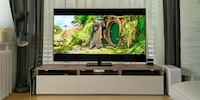
Product test
OLED for the discerning? What Panasonic's Z85A can really do
by Luca Fontana

OLED was yesterday? With the Bravia 9, Sony wants to prove that mini-LED can keep up. With extreme brightness and precise local dimming, the TV promises a picture in a class of its own. But can it fulfil the high expectations?
Full Disclosure: The TV, the 75-inch version of the Bravia 9, was provided to me by Sony for testing. I would like to emphasise that I conduct my tests independently and Sony has no influence whatsoever on the test result or my evaluation.
After initial delivery problems, I was finally able to test the TV at home, using my own instruments and reference examples of course. Spoiler: Sony did not cheat.
This year, Sony is sticking to its industrial look with two black, metal duck feet. Not really my style, but it is practical. Firstly, because the feet are not positioned in the centre, as with most competitors. Secondly, because it leaves a gap of around eight centimetres between the panel and the TV cabinet. This leaves enough space for most large soundbars without them protruding into the picture.
This gap would only be unfortunate if you don't have a soundbar. But Sony has also thought of this. The two duck feet can also be attached to the panel in such a way that the gap is "closed". The flat feet are then barely visible at the front and back, while the panel sits almost directly on the furniture.
But we'll get to all of this further down in the test.
About the specs. Sony's Bravia 9 offers the following:
Another word about the weight. The 75-inch TV - it doesn't get any smaller; only bigger - weighs 42.3 kilograms without the stand. If you want to mount the TV on the wall, you will therefore need a VESA 300×300mm mount. You can find this here in our shop.
Update from 12 September 2024: Sony has announced that it will launch the 65-inch version from January 2025. Top!
The most important findings in brief:
About the measurements. I measured all screen modes of the TV without calibrating it - just as the device comes out of the box. I only made a few changes to the standard settings:
What can I say? When I mentioned "amazingly high maximum brightness" at the beginning, it was not without reason:
In terms of brightness in the 100 per cent window - i.e. an image section as large as the entire display itself - the Bravia 9 is also no slouch. With 837 nit, it easily outshines its predecessor. LG's G4 even "only" achieves 253 nit. An excellent value for an OLED television. But here it becomes clear that the overall brightness of an OLED TV can never compete with that of an LCD TV.
Let's take a look at how well Sony's flagship this year reproduces white, colours and shades of grey. I'll answer that in three questions:
Each pixel in the Bravia 9 consists of a red, green and blue subpixel. White is created when they all shine at the same time and with the same intensity. Full brightness produces the brightest white. The lowest brightness, on the other hand, produces the darkest white - i.e. black. In between are shades of grey of varying brightness. This is why the English term "grayscale measurement" is used.
The grayscale measurement of Sony's Bravia 9 is convincing. The grey tones deviate only slightly from the target value: I measure an average DeltaE of just 1.05 - even if the blue and green content is slightly too high and the red content slightly too low in lighter grey tones. However, the deviation is hardly visible to the untrained eye. For comparison: Sony's X95L achieved a DeltaE of 3.38 in the greyscale measurement.
I measure the coverage of the colour spaces:
The Bravia 9 achieves an excellent 94.84 per cent coverage in the important DCI-P3 colour space. This is slightly less than the 96.58 per cent coverage achieved by LG's G4. Or the 99.78 per cent of the A95L from Sony, a QD OLED TV. But in practice, this makes no visible difference.
In terms of coverage of the very large BT.2020 colour space, Sony's mini LED TV performs slightly less well at 79.96 per cent. Currently, only QD OLED televisions achieve 90 per cent coverage of the BT.2020 colour space. The film and series industry therefore calibrates its HDR content in the much more widespread DCI-P3 colour space. BT.2020 coverage therefore serves more as an indicator of a television's suitability for the future.
The third question: colour fidelity. This describes how accurately colours are displayed. As with greyscale, the deviation from the TV to the reference value is referred to as DeltaE. The white boxes show the reference colours sent to the TV by the test pattern generator, while the black circles show the colours actually measured.
The measurements here are a little disappointing. Sony's Bravia 9 "only" has inherently good colour fidelity in Dolby Vision mode: With a total of 40 measured values, I get an average DeltaE of 4.07. This is too far above the targeted DeltaE value of 3 for my idea of a top TV, at which only professionals can recognise the deviation from a reference monitor with the naked eye.
For comparison: In cinema mode, the Bravia 9 achieves a DeltaE of 3.63. LG's G4 achieved a much better DeltaE of 2.95.
Reflections on the screen are not measurable per se. Nevertheless, it is important to address them in tests. For comparison, I'll take a picture from my test with LG's G4. The photos were taken around midday and without any attempt to darken the room.
On the display of Sony's Bravia 9, not only the orange room lamp is clearly visible, but even the entire flat! Plus: unsightly rainbow streaks. You can see these mainly on the left-hand side of the Bravia 9 picture.
Luckily for Sony, the Bravia 9 is so bright that I only rarely noticed the streaks in real everyday situations. If I did, then only during the day in dark scenes. For example, at the beginning of "Blade Runner 2049". Here's a comparison of how the reflections affect the picture when it's switched on:
You see: Even in a "dark" scene, most of the reflections already disappear and are outshone by the brightness of the TV itself. Only the orange light annoys me in this example.
But so be it. According to Sony, the claim is that the Bravia 9 should compete with other top TVs and not with last year's inferior model anyway.
Sony told me back in the spring that they had developed the smallest LED controllers on the market. These not only provide more brightness and therefore better contrast, but also enable the most precise control of local dimming zones ever (local dimming). Sony calls this sonorously the XR Backlight Master Drive. Blooming - the outshining of bright, small objects against a dark background - should now be a thing of the past.
For years, I have made it anything but easy for televisions in my local dimming and blooming test. In the comparison below from the series "Westworld", watch the face of the Asian man as he gets up from the table. Or the shirt of the South American gentleman. Or the dark area to the left of the woman's face. Or on the light in the background.
The blooming on LG's 8K TV from 2020 is almost unbearable. Over the years, however, more and more dimming zones were added. Today, in 2024, I actually no longer see any blooming on the Bravia 9. That's great!
When I want to test a TV for its colour reproduction, I go back to "Guardians of the Galaxy, Vol. 2". This scene in particular: it should show the finest details on Drax's tattooed skin without overemphasising them, have that certain punch in the picture and make Ego's palace pop in the saturated evening red. Sony's Bravia 9 is very much in line with the director's intention of capturing the planet's kitschy "Golden Hour".
Compared to LG's G4 and Sony's A95L, however, I find the Bravia 9 picture a tad too green-yellowish. I like the warm, reddish skin tones of the OLED and QD OLED picture better. With Sony's QD OLED panel, the skin tones in particular look a little more natural.
I find it a little more difficult to pass judgement on "James Bond - Skyfall" when James and the young quartermaster Q look at a picture of a proud old battleship being ignominiously dragged to the scrapyard in an art museum. An allusion, of course, to the ageing secret agent who everyone wants to write off, even if he still wants to know.
Here, Sony's Bravia 9 and LG's G4 paint a similarly natural picture. I pay particular attention to the skin tones. In this respect, Sony's A95L is almost a little oversaturated, even if some people might like the warm colours better. A matter of taste, I guess.
How does Sony's mini LED TV perform in dark scenes? For this test, the first scene from "Blade Runner 2049" comes into play.
A final image test: Detail reproduction in bright image areas. In the following "Jurassic World" example on the Bravia 9, pay attention to the sun in the background: even in such a bright image area, the gradations between the individual orange tones in the sky are still so fine that the sun can be easily recognised as a sphere in the firmament without visible gradations in the form of white circles around it.
In this discipline, LG's G4 and Sony's A95L are no slouch either. However, I had to set the smooth gradation for HDR content to "Medium" in the settings for LG.
The processor is the brain of the TV. Its main task is to receive, process and display image signals. In doing so, the processor recognises poor picture quality and enhances it by removing noise, boosting colours, smoothing edges, making movements smoother and adding missing pixel information.
To start with, I make it really difficult for the processor. Specifically: Judder, a phenomenon that all TVs have. Especially with long camera pans. Sam Mendes' "1917" is full of such smooth, slowly flowing camera movements and is therefore perfect for the judder test. When making a comparison, pay particular attention to whether the vertical bars in the barn run smoothly through the picture or start to "stutter".
Next scene from "1917". Here, too, Mendes' camera work poses an immense challenge for most processors. Especially with hard edges against a blurred background, for example around the helmets of the two soldiers. Here, both the processor and the pixels have to react incredibly quickly.
Here too, Sony's XR Master Drive processor compares favourably with LG's Alpha 11 - albeit not quite at the same ultra-smooth level. Sony's X95L and its old processor, on the other hand, are visibly overwhelmed by this scene, while Sony's A95L could certainly have achieved a little less judder if I had intervened in the judder settings back then.
Next up, the Apple original "For All Mankind". I want to see how long it takes a single pixel to change colour. If this doesn't happen fast enough, it looks to you as if the image is streaking - the effect is called "ghosting". When panning the camera across the surface of the moon, pay attention to the text displayed at the bottom left.
Problems? Not at all. At least not with Sony and LG, where the superimposed text always remains sharp. But to give you an idea of what the smearing I'm talking about looks like, I've included a comparison with TCL's C82 model at the end. To be fair, it has to be said that this is a TV that is two years older. The example is therefore for illustrative purposes only. TCL has already made significant improvements with its successor models.
Now for the most demanding test: I want to see how well the processor upscales low-quality sources, such as Blu-rays, live television or "The Walking Dead". This series was deliberately shot on 16 mm film to create the feeling of a broken, post-apocalyptic world through the old grain and image noise.
When measuring the colour correctness in gaming mode, I achieved an average Delta E of a very good 3.36 (see "White balance, colours and grey tones" above if you are interested in the details of this topic). This is one of the better values I've measured in gaming mode on a TV - but no better than LG's G4.
Apart from this, the TV supports all features relevant for gamers:
To this end, Sony, along with Samsung, LG, Philips, TCL and Panasonic, has entered into a partnership with major gaming studios. The result is the HGiG - the HDR Gaming Interest Group. According to the manufacturer, the aim is to ensure that HDR is displayed as intended by the game developers, for example when playing "Spider-Man 2" on my PlayStation 5.
What Sony offers here is a feast for the eyes. At a stable 120 frames per second, I swing through the urban canyons at breakneck speed, overpower opponents in heated battles thanks to barely noticeable input lag and enjoy the liberating glide over the rooftops of New York. Brilliant colours, perfect contrasts with deep blacks, sharp edges and a picture that doesn't smudge even when the camera pans quickly round off the experience.
This is what a good gaming mode looks like.
By the way, the annoying film and series recommendations on the home screen can also be easily switched off:
Another treat: Sony has added an art mode. Instead of switching off the TV, you can display beautiful pictures with the date and time. This replaces the rectangular, black hole in the living room that a switched-off TV usually represents with an attractive alternative - and with low energy and brightness. Example: See the Header image above.
Sony's Bravia 9 is an extremely impressive mini LED TV. Its immense brightness, precise control of the dimming zones and natural colour reproduction in particular make it a real - and literal - highlight.
However, it is not quite enough for the top position, as the Bravia 9 falls slightly short of the OLED competition in terms of colour fidelity. In addition, reflections are clearly visible during the day, even if these are compensated for in most situations by the high luminosity of the display.
The XR Master Drive processor, on the other hand, impresses with its performance, especially when upscaling and gaming. Google TV as the operating system rounds off the package with comprehensive and intuitive smart TV software. This makes the Sony Bravia 9 a television that fulfils high demands and offers impressive performance.
Pro
Contra
I write about technology as if it were cinema, and about films as if they were real life. Between bits and blockbusters, I’m after stories that move people, not just generate clicks. And yes – sometimes I listen to film scores louder than I probably should.
Not all that glitters is OLED - especially at Sony. The Japanese manufacturer has been pursuing a multi-pronged strategy for years: it buys the best displays from the competition and combines them with its own superior processor. In this way, Sony plays several display markets at the same time and leaves the costs for research and development of new display technologies to others.
At the centre of this review: Sony's Bravia 9, a mini LED TV that aims to take on OLED sets. The Bravia 9 is not just a mere successor to the X95L, which I tested last year. Sony promised a visible upgrade over last year's model back in the spring, thanks in particular to an impressive number of dimming zones and an amazingly high maximum brightness - hence the completely new name.
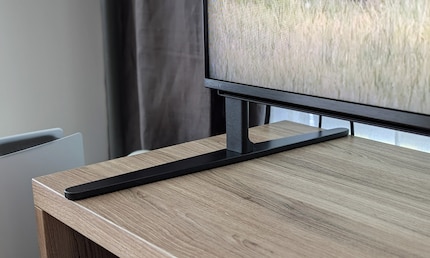
From the side, Sony's Bravia 9 is slightly thinner than its predecessor, but at around five centimetres, it is still quite thick. This is due to the additional LED layer that illuminates the LCD pixels in the panel. In other words: mini-LEDs. OLED televisions are significantly thinner because they do not need this layer; OLED pixels emit light by themselves. This has advantages when displaying perfect black, which in turn has an effect on rich, high-contrast colour reproduction. However, OLED pixels generally do not shine as brightly as mini-LED pixels.
All four HDMI inputs support HLG, HDR10 and Dolby Vision. Only HDR10+ is missing. But its distribution is very limited anyway: to date, I have only seen isolated HDR10+ content on Amazon Prime Video. The pass-through function for Dolby Atmos and DTS 5.1 audio signals is a very positive feature. You will need this if you use an external device as a player. A UHD Blu-ray player, for example. Unfortunately, I was unable to test whether the pass-through function also works with DTS:X because my soundbar - a Sonos Arc - only supports a maximum of DTS 5.1 Surround.
What comes next goes deep into the subject matter. I measure with professional tools from Portrait Display to get an objective categorisation of the picture quality. If you are not interested in details and diagrams, you can read the following short version and then scroll to the chapter "The picture: Mini-LED shines, but OLED remains the reference".
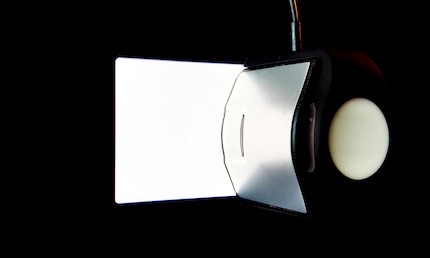
The cinema mode achieved the best measured values for all types of content. But because most HDR content is now almost exclusively available in Dolby Vision quality - whether from 4K Blu-ray or streaming services - I present the Dolby Vision measurements here. The difference between the two modes was so small anyway that only experts would notice it - if at all. For the most accurate picture, it's therefore best to use either cinema or Dolby Vision mode. Except when gaming, you should always use Gaming mode because of the input lag.
Let's take a look at the brightness of the Bravia 9. In the chart below, I compare it with its direct predecessor, the X95L, and Samsung's QN95B, a mini LED TV from 2022. Samsung's current mini-LED flagship, the QN900D, will be tested in late summer. To demonstrate the difference in brightness between mini-LED and OLED, I've also included the values of the LG G4, which I tested at the beginning of the summer.
The Bravia 9 achieves a peak brightness of an incredible 3178 nit at a window size of ten per cent. This is an impressive value even for a mini LED TV. If a television shines brightly at certain points and in very small areas of the picture, this usually means better contrast and more colours. To categorise: OLED televisions may not shine as brightly as LCD televisions, but they often score higher in terms of contrast. This is because they are vastly superior to LCD televisions on the other side of the spectrum - the black level. This is referred to as "true black", i.e. "real black".
The greater the difference between the brightest and darkest pixels, the better the contrast values. With an OLED TV, I don't need to measure the contrast because OLED pixels can switch off completely. This means that the contrast ratio tends towards infinity, as indicated above in the chapter "Maximum brightness". Sony's Bravia 9, on the other hand, achieves a contrast ratio of 391,521:1 in my measurement. This is an excellent value for an LCD television, which the Bravia 9 probably owes to its superb peak brightness - but also its very good black levels thanks to local dimming. We'll come to local dimming later.
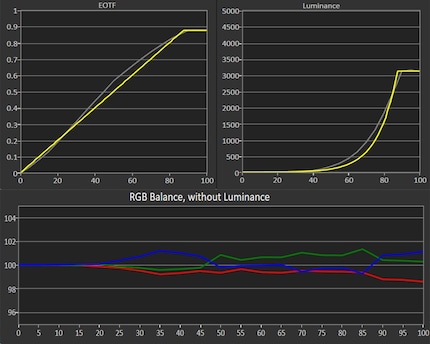
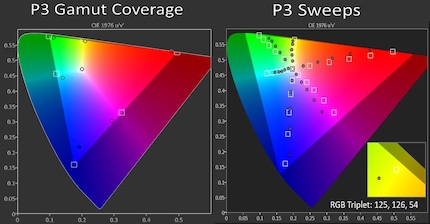
The picture is extremely bright and offers good colour fidelity ex works - in theory. But what does it look like in practice? I would actually have liked to compare the Bravia 9 from Sony with its direct predecessor. But - shame on me - due to a hardware defect at the beginning of the year, I lost a lot of filmed material from previous years. Therefore, in many cases I can unfortunately only offer a direct comparison with LG's current flagship, the OLED G4, and Sony's last year's top model, the QD-OLED A95L. In my test, I even called the A95L the "king of TVs".
To add some variety, I've included a scene from "Avatar: The Way of Water" for testing, where green and especially blue tones dominate. Especially with the bluish skin tone of the nature-loving Na'vi, it quickly becomes apparent that LG's G4 has slightly more dynamics. On the other hand, the green of the jungle "pops" a little more on Sony's Bravia 9. However, I notice the biggest difference in comparison to Sony's A95L, where the picture appears much richer and warmer.
LG and Sony's (QD) OLED TVs produce a wonderfully dark picture. If you film against the light, it is normal for details to be "swallowed up" in black silhouettes - called black crush. I like that. However, some of you have already commented that too many details are swallowed up. The Bravia 9 is therefore the better choice for you: although black is not as pitch black as on the other two TVs, it is anything but bad thanks to the excellent local dimming. In addition, many details remain clearly visible even in dark areas of the picture. A very nice balancing act that the Bravia 9 achieves.
LG still shows where the hammer hangs thanks to its new Alpha 11 processor: there is hardly a trace of Judder to be seen. But Sony's Bravia 9 keeps up superbly. Also because I adjusted the settings slightly this time: Motionflow to "Minimum", CineMotion to "High". In the second comparison - I actually found some X95L material - you can see what really bad Judder looks like. But Sony didn't use an XR master drive processor back then either. It's quite possible that the LCD pixels react much slower because of this. Sony's A95L looks a little better than the X95L: OLED pixels are inherently faster than LCD pixels due to the technology involved.
Sony's XR Master Drive processor cuts an excellent figure here. Compared to LG's G4 with its Alpha 11 processor - which has always been damn good in this discipline - I see almost no differences. I pay particular attention to the dark area between the two rivals. There is almost no image noise. Almost no compression artefacts. In addition, the picture is sharply defined, pleasantly warm, rich and yet natural. I am impressed. Look at the same area in the second comparison with Sony's processor, which is only one year older. There is a little more noise to be recognised.
On the topic of input lag: With the measuring device from Leo Bodnar, I measured an average input lag of 17.7 milliseconds with a UHD picture at 60 frames per second and HDR enabled. This is not overwhelming, but slightly faster than the X95L from the previous year. The value is also below the 20 milliseconds that a game mode should achieve in 2024. For comparison: LG's G4 achieves 9.8 milliseconds here.
Sony relies on Google TV, which was completely overhauled two years ago - much to my delight. Previously disdained, I now consider Google TV to be one of the most comprehensive and at the same time clearest operating systems in the TV sector. Thanks to the excellent processor in the A95L, Google TV also runs smoothly and without any noticeable stuttering. An all-round successful smart TV package.


Acer Nitro VG271UM3bmiipx
2560 x 1440 pixels, 27"